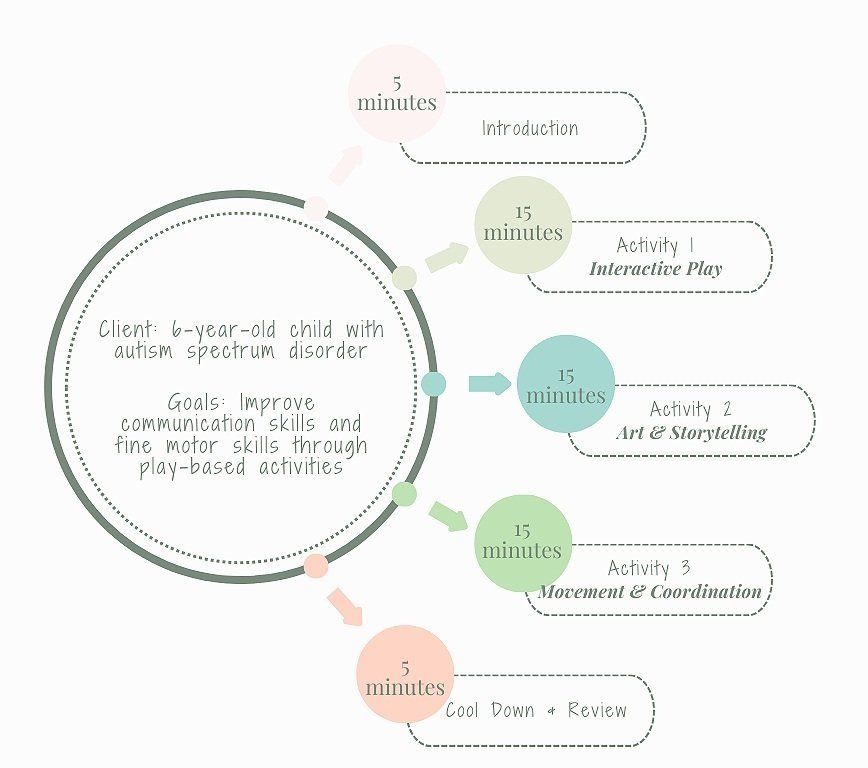Co-Treat Model
When working with children, speech pathologists and occupational therapists often have similar goals or areas of focus that overlap for both clinicians. At Little Palms Pediatric Speech & OT, the co-treating team consists of a speech pathologist and an occupational therapist working closely with your child simultaneously in a joint therapy session. The expertise and skilled perspectives of both clinicians help to maximize therapeutic collaboration and ensure that your child's goals are being targeted in the most effective way possible. Research has shown that utilizing a holistic and comprehensive therapeutic approach can lead to greater success across sessions as well as greater responses to treatment. The co-treating model is beneficial to the child, parents/caregivers, and the clinicians.
It can be difficult for many children to sustain attention and maintain optimal arousal level needed to actively participate in therapy for two back-to-back sessions. By working with both your speech pathologist and occupational therapist at the same time, the child still receives both therapies and works toward both disciplines’ goals in a shorter amount of time.
On a daily basis, we simultaneously use communication, self-regulation, motor skills, and social skills. The activities thoughtfully planned by the clinicians can incorporate these skills in therapy sessions and replicate real life settings. This can assist your child to use those meaningful skills taught in therapy in everyday life!
Speech and occupational therapists working alongside one another facilitates goal-oriented learning and skill-building while enhancing generalization of skills. When a child uses a newly acquired skill with different people and in a variety of situations, the skill will more likely transfer in a seamless and functional way.
Working with two clinicians at the same time increases the number of people your child interacts with at once. Working one-on-one can be challenging; however, with the addition of another skilled therapist, the child is better able to work on skills such as social interactions (turn taking, winning/losing, sharing).
Benefits for the Child
The strategies and tools used in treatment sessions and shared with parents/caregivers are consistent across all sessions. This reduces confusion and ensures that your child is learning and being supported.
Having two therapists in the session simultaneously means you will not have to repeat information or answer the same questions more than once.
As one therapist engages with your child, the other can educate you, providing personalized strategies, addressing any concerns, and equipping you with the tools needed to support your child at home and in the community.
Combining speech and occupational therapy sessions makes better use of valuable time. Rather than attending two separate 45-minute sessions and spending additional time commuting, a single one-hour joint session can help you save time throughout your week.
Benefits for the Parents & Caregivers
Ongoing collaboration of clinical skills creates more opportunities for clinicians to learn and develop their skillset. As allied health professionals, we are constantly enhancing our skills and learning new strategies, activities, and evidence-based practices to best support your child's needs. This continuous learning is essential for delivering effective services.
Joint sessions enhance communication among therapists. They often further facilitate dialogue, enabling therapists and parents/caregivers to align goals and the strategies needed to achieve them.
Sharing knowledge about specific clinical skills is most effective when both disciplines are present. This enables speech therapists to provide essential tips and strategies that occupational therapists can use for communication during activities in real time. In the same manner, occupational therapists can share invaluable insights regarding fine motor, gross motor, and regulation skills for speech pathologists to consider.
Collaboration among therapists promotes participation and positive behavior during treatment sessions. Consistency in this approach is crucial in helping a child understand behavioral expectations, ultimately leading to the greatest benefit from treatment.
Benefits for the Clinicians
Co-treating session example
-
The speech and occupational therapist greet the child and explain the activities.
The therapists briefly review previous goals and progress with the child.
-
Materials: Building blocks, figurines, and a storybook
Objective: Encourage turn taking, language development, and fine motor skills
Speech Therapist’s Role:
Model language by describing actions and asking open-ended questions (e.g., “What do you want to build?”).
Encourage the child to use new vocabulary.
Occupational Therapist’s Role:
Facilitate manipulation of blocks to improve grip and coordination.
Encourage the child to use both hands for building to promote bilateral coordination.
-
Materials: Crayons, paper, and a visual schedule
Objective: Enhance expressive language and fine motor skills
Speech Therapist’s Role:
Ask the child to narrate a story about his/her drawing.
Encourage use of descriptive language and sentence formation.
Occupational Therapist’s Role:
Support the child to properly hold crayons and use a variety of colors.
Assist with cutting or gluing, focusing on hand strength and dexterity.
-
Materials: Obstacle course equipment (e.g., tunnels, scooter, cushions)
Objective: Promote physical skills while using communication cues
Speech Therapist’s Role:
Use visual or verbal prompts to guide the child through the course (e.g., “Jump over the pillow!”).
Reinforce language concepts like under, over, and through.
Occupational Therapist’s Role:
Support the child’s physical navigation through the course.
Encourage sensorimotor skills such as balance, gross motor coordination, body awareness, and proprioception.
-
Gather in a calm space to discuss what activities the child completed.
The speech and occupational therapist ask the child about his/her favorite part of the session, promoting language use.
The speech therapist notes communication progress while the occupational therapist assesses motor skills demonstrated.

